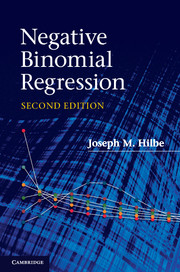Book contents
- Frontmatter
- Contents
- Preface to the second edition
- 1 Introduction
- 2 The concept of risk
- 3 Overview of count response models
- 4 Methods of estimation
- 5 Assessment of count models
- 6 Poisson regression
- 7 Overdispersion
- 8 Negative binomial regression
- 9 Negative binomial regression: modeling
- 10 Alternative variance parameterizations
- 11 Problems with zero counts
- 12 Censored and truncated count models
- 13 Handling endogeneity and latent class models
- 14 Count panel models
- 15 Bayesian negative binomial models
- Appendix A Constructing and interpreting interaction terms
- Appendix B Data sets, commands, functions
- References and further reading
- Index
13 - Handling endogeneity and latent class models
Published online by Cambridge University Press: 05 June 2012
- Frontmatter
- Contents
- Preface to the second edition
- 1 Introduction
- 2 The concept of risk
- 3 Overview of count response models
- 4 Methods of estimation
- 5 Assessment of count models
- 6 Poisson regression
- 7 Overdispersion
- 8 Negative binomial regression
- 9 Negative binomial regression: modeling
- 10 Alternative variance parameterizations
- 11 Problems with zero counts
- 12 Censored and truncated count models
- 13 Handling endogeneity and latent class models
- 14 Count panel models
- 15 Bayesian negative binomial models
- Appendix A Constructing and interpreting interaction terms
- Appendix B Data sets, commands, functions
- References and further reading
- Index
Summary
This chapter takes us into areas that have been primarily addressed in the econometric literature. However, the methods discussed are just as appropriate for research in biostatistics and medical health, and in social and political analysis. Recall that hurdle, zero-inflated, and selection models all partition the response distribution into two components. Zero-inflated models explain excessive zero counts using a binary generating process, which is mixed with a Poisson generating process, including zero. Hurdle models, on the other hand, are also partitioned into binary and count components, but the counts are generated by two separate processes with no overlapping mixture. Zero versus positive counts are formatted into a binary model and a zero-truncated count model generating the positive counts. We found that zero-inflated models employ traditional binary models such as logit and probit regression for understanding the zero counts, whereas the binary component of the hurdle model may be a right censored at 1 count model or a traditional binary model. The finite mixture models discussed in Section 11.1 extend hurdle models in such a manner that processes generating disparate types of counts may be identified.
We follow an examination of finite mixture models with an overview of the methods used to deal with the problem of endogenous predictors. Actually, endogeneity touches on finite mixture models, as well as on count models with unexplained heterogeneity in general, e.g. generalized Waring regression.
- Type
- Chapter
- Information
- Negative Binomial Regression , pp. 407 - 446Publisher: Cambridge University PressPrint publication year: 2011
- 1
- Cited by



